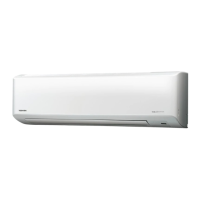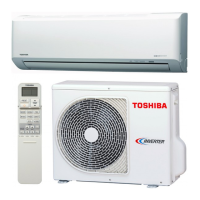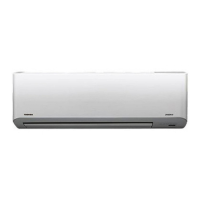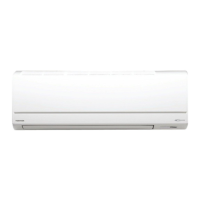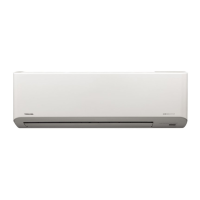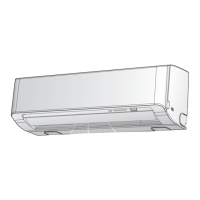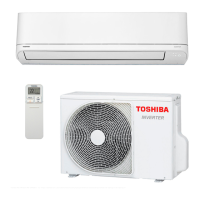
Do you have a question about the Toshiba RAS-10N3AV2-E and is the answer not in the manual?
| Brand | Toshiba |
|---|---|
| Model | RAS-10N3AV2-E |
| Category | Air Conditioner |
| Language | English |
Requirements for power supply cord for outdoor units.
Warnings regarding R410A refrigerant during installation.
DANGER and WARNING statements for installation and operation.
Warnings and precautions for installation work, tools, wiring, and earthing.
Cautions regarding unit placement, water exposure, damage, and user explanation.
Technical specifications for indoor and outdoor units, including capacity, power, noise, dimensions.
Graphs showing current vs. compressor speed for cooling and heating.
Graphs illustrating capacity changes based on outdoor temperature.
Safety rules for handling R410A during installation and servicing.
Guidelines for piping materials, processing, flare dimensions, and connections.
Lists tools exclusive to R410A and general tools needed for installation.
Steps for charging the correct amount of refrigerant, including vacuuming.
Describes brazing fillers, flux, and methods to prevent oxidation.
Exploded view and dimensions of the indoor unit, including accessories.
Exploded view and dimensions of the outdoor unit, including installation details.
Diagram illustrating the electrical connections between components of the air conditioner.
Lists parts and their specifications for the indoor unit.
Lists parts and their specifications for the outdoor unit.
Illustrates the refrigerant cycle for cooling and heating operations.
Provides operational data for cooling and heating modes at specific temperatures.
Block diagram showing the control functions and signals for the indoor unit.
Block diagram showing the control functions and signals for the outdoor unit.
General explanation of the air conditioner's control system and components.
Describes how user conditions are received and units are controlled.
Details on how cooling, heating, auto, and dry modes operate.
Explains indoor fan speed control in cooling mode.
Explains indoor fan speed control in heating mode and cold draft prevention.
Details outdoor fan speed control based on temperature and compressor speed.
Explains capacity adjustment and current release control for inverter protection.
Controls compressor speed to prevent freezing or over-pressure.
Procedure to remove frost from the outdoor heat exchanger.
Controls air direction via position, adjustment, and swing functions.
Energy-saving operation mode that adjusts temperature and fan speed.
Procedures for temporary operation and discharge temp. control for error detection.
Controls refrigerant flow by adjusting the valve opening degree.
Minimizes mold and bacteria growth by drying the interior.
Guides for separating remote control for multiple indoor units.
Explains quiet, comfort sleep, and one-touch operation modes.
Details Hi-POWER mode and filter cleaning indicator function.
Instructions on how to enable the automatic restart feature after power loss.
Procedures to cancel auto restart and notes on power failure during timer operation.
Identifies and describes the functions of each button on the remote controller.
Explains how to use the remote for One-Touch, Auto, and mode selection operations.
Details remote operations for Dry, Hi-Power, ECO, Temporary, and Timer functions.
Explains remote operations for Preset, Auto Restart, Quiet, and Comfort Sleep modes.
Explains the meaning of various icons and indicators on the remote control display.
Diagram showing the general layout for installing indoor and outdoor units.
Lists optional parts and details on securing the outdoor unit.
Comprehensive list of all included accessories and installation components.
Describes new tools required for R410A and changes from R22 tools.
Guidelines for selecting the optimal placement for the indoor unit.
Instructions for drilling holes and mounting the installation plate.
Step-by-step instructions for connecting the indoor unit's wiring.
Instructions for connecting the remote controller for wired operation.
Procedures for forming pipes and installing the drain hose.
Guidelines for selecting the optimal placement for the outdoor unit.
Instructions for connecting refrigerant pipes using the flare method.
Details on tightening flare nuts and connections using a torque wrench.
Procedure for removing air from the system using a vacuum pump.
Requirements for power supply and connecting cables for the outdoor unit.
Procedure for checking refrigerant gas leaks using detector or soap water.
Method to prevent interference when using multiple remotes.
Instructions for test operation and setting the auto restart function.
Checks for normal power, voltage, non-trouble states, and inverter safety.
Uses LED codes, remote controller service mode, and diagnostic codes for fault identification.
Diagnoses issues based on symptoms like no power, fan failure, wiring, or remote control problems.
Procedures for checking main parts, inverter, P.C. boards, sensors, and motors.
Judging the outdoor fan motor's condition through resistance checks.
Safety and steps for replacing indoor unit parts like panel, motor, and evaporator.
Procedure for replacing the microcomputer and related parts.
Safety and steps for replacing outdoor unit parts like cabinets, inverter, control board, and compressor.
Diagram showing disassembled indoor unit parts with corresponding part numbers.
Detailed diagram of disassembled indoor unit components with part numbers.
Diagram showing disassembled outdoor unit parts with corresponding part numbers.
Diagram illustrating the layout of components on the P.C. board.
